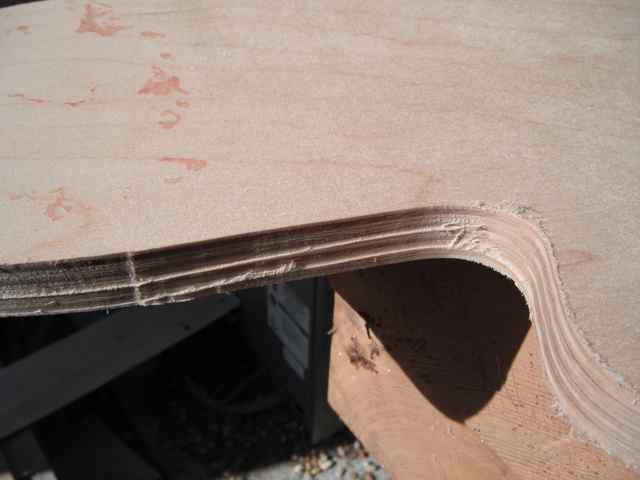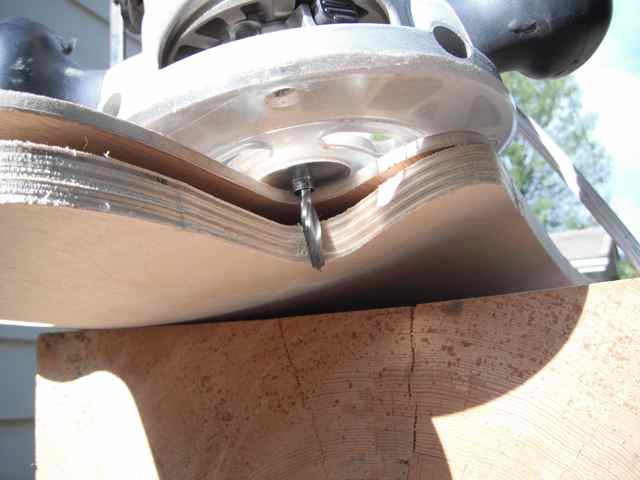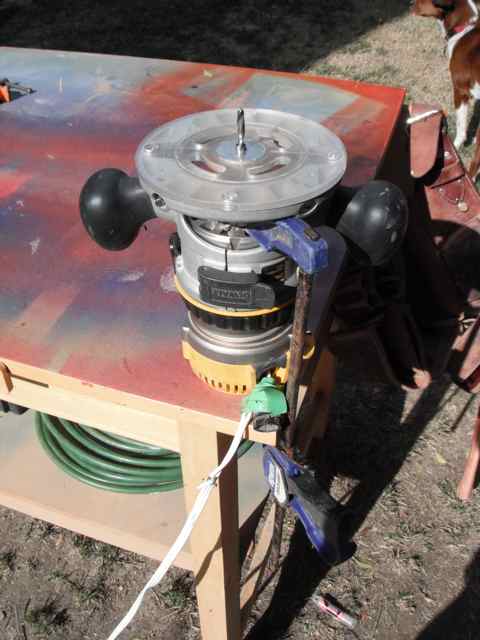Question
Today I tried using a 1/4" up cut spiral bit and a 5/16" bushing with a template to cut out a pattern that is made out of 1/2" Baltic birch. The bit broke and a 1/2" bit bogs down the motor on my POS Dewalt 2-1/4 hp. The Porter Cable 7518 is 3-1/4 hp.
I want to be able to cut out a pattern in one pass without rough cutting out the pattern and would like to do it with a handheld router, a template bushing and a down cut spiral so as to eject the chips and not just have them bounce against the bushing. If I can cut out the pattern in one pass the chips should be ejected through the substrate and out the bottom, allowing the bit to work efficiently.
I have tried doing multiple passes and that produces steps in the substrate, as pictured. The multiple passes take too long as well. Also, the pattern is flat and the substrate it concave, as pictured. Finally, I am using a real piece of crap router, as pictured. I am not using the router clamped to the table, as pictured. I'm using it as a handheld.
Do you think that the Porter Cable 7518 will be able to cut 1/2" thick material in one pass as a handheld with a 1/2" bit and bushing? I'm concerned there will be too much chatter for this operation to be done with a hand held.



Forum Responses
(Solid Wood Machining Forum)
From contributor D:
Have you tried using a slightly bigger collar with 3 flute hogger for a first pass? It will go through like butter, leaving a rough finish. Then clean up with your regular rig. Ideally a collar no more than 1/8" bigger diameter so your finishing bit is just kissing it.
No. Cutting stuff in one pass is usually not good millwork practice anyway. Even if you were doing this with a ten hp CNC router, you would still probably work it as contributor D has suggested.
As far as never making one pass, I use a router with 10HP spindle, and it slices through 1/2" or 3/4" Baltic birch with ease and leaves a beautiful finish. It can be done with a 1/4" bit but it is slow, as it's limited by the strength of the tool. The difference in noise and chatter is night and day between 1/2" and 3/8" cutters in a deeper cut (3/8" being much quieter). I know it's not a PC 7518, but those are still pretty powerful - that is what we use in the router tables, and I know it can make a single pass in 1/2" without killing it.
Another thought. Since you're not probably going to be moving very fast cutting by hand, you might want to save money and buy some cheap single and double flute carbide tipped instead of the spirals. I typically don't use spirals when hand feeding because I find the bits burn up easier with the stop and go and inconsistent hand feed speed. A regular tipped bit works just as well if not better in some situations.
You mention production. If you're doing a lot of these it may make sense to look into picking up a pin router. There are so many out there going for short money it might be a good option for you? I'm just not sure how the non-flat substrate would work with one?
I also have some old and mighty pin routers that can indeed make the cut (especially my good-old Onsrud) but not without a mighty (stupid) effort on my part. I hear from time to time guys bragging about making heavy millwork cuts in a single pass. These are guys I generally don't want working for me. I don't believe in forcing the issue when it comes to man and machine (I've learned the hard way). The mere fact that you're posing this question suggests that you already know (or suspect) that this may not be quite right.
Power tools and equipment will often let you know when you're trying to do something stupid. Ignore them at your own peril.
Meaning no disrespect to contributor O whom I'm sure knows his own equipment capabilities, handheld routing operations are a different matter entirely and warrant considerable caution and respect.
If you secure you pattern to your material well, clamp the whole thing down to something sturdy, keep two hands on the router and take it a little slower I would think your Dewalt might be able to do the same thing. If not with the same bit I was using, I would think for sure with a rougher. If your pattern is not secured well to the material, I doubt you're ever going to get a quality cut no matter how many passes you make.
Before everything was cut on a CNC, I did my fair share of routing odd parts by hand using templates and router/bushing setup just like the questioner. I'm not trying to give bad advice, just help him reach his goal of efficiently cutting the parts in one pass, which is definitely an option with the tools discussed. Multiple passes is the obvious easy/simple answer and by no means wrong, but if he's got a lot of this to do, it almost doubles the work he's got, and I doubt he's got the option of doubling what he getting paid to cut these parts, and I am confident there are more solutions to this problem than to make multiple passes.
One option besides the collar is a pattern bit. If you aren't familiar with them, they're just like a flush trimmer with the bearing on the bottom.
I'm also looking into these pin routers. I've never heard of them. I install millwork so I am not that familiar with shop based equipment. I imagine I could use a flat pattern on the table and build a jig to hold the material on top of the pattern. The pieces I'm cutting have a 5/8" concave to them plus the 1/2" of material so I could easily use a bit with an inch and a half cut. Like I mentioned, I work in the field so I'm looking into bench top pin routers. There are some shop built ones on youtube also.
I really hate the idea of making multiple passes. The concave of the work piece means that I have to adjust my router multiple times because the flat template moves away from and then closer to the work piece. The first pass on one end of the template would cut clean through on the other end without adjusting the depth of cut part way through. I got impatient and didn't let my router bit stop turning before I loosened the base and the bit became misaligned with the bushing and cut my bushing. Not only did I break a bit, but the bushing also!
Thanks for checking out the situation with the 7518. The auction I was watching had one for $200 used, but that auction ended. I like buying new anyway.
Editor's Note: For top quality carbide cutters (upcut, downcut, straight flute) consider LMT Onsrud (website).